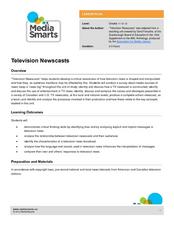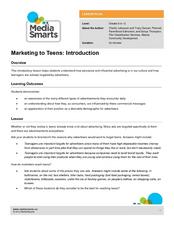Media Smarts
Bias
See how bias operates firsthand. Half of the class reads one article while the other half reads another article on the same event. The obvious differences emerge when the two sides talk about their observations though. Several handouts...
American Press Institute
In the Newsroom: The Fairness Formula
Reporting the news is easy, right? Think again! Show young scholars the difficult choices journalists make every day through a lesson that includes reading, writing, and discussion elements. Individuals compare the language and sources...
Curated OER
Television Newscasts
When we watch news broadcasts on television, we receive a much more visual perspective than when we read the newspaper. How do sets, clothing, and music contribute to our understanding of the story? Compare American and Canadian news...
Curated OER
Journalism with Natalie Moore
Students analyze journalism in the 21st century. In this journalism lesson, students read about Natalie Moore and the changing field of journalism by completing the activities in the packet.
Curated OER
Media Awareness: Helping a Product Cross the Finish Line
Students develop critical thinking skills to understand and create advertisements. In this journalism lesson, students analyze the elements necessary for effective advertisements and work in cooperative groups to create and present...
Curated OER
Dissecting the Media
Young scholars examine an editorial point of view in journalism and explore how this contributes to the West's understanding of events in the Middle East. They discuss the concepts of objectivity and subjectivity, and how tone and...
Media Smarts
Marketing to Teens: Gender Roles in Advertising
Young learners explore gender roles in advertising by taking an ad campaign they have seen which is specifically directed to one gender, and redesigning the campaign to target the opposite gender. After leading a guided discussion about...
Curated OER
Marketing to Teens: Introduction
An introductory lesson plan shows learners how pervasive and influential advertising is in our culture; particularly, how teenagers are actively targeted by advertisers. As teenagers, your learners already have all the information they...
Newseum
Civil Rights News Coverage: Looking Back at Bias
Not all southern newspapers covered the civil rights movement of the 1950s and 1960s. Young journalists investigate how The Lexington (Ky. Herald-Leader and The Jackson (Tenn.) Sun re-examined their coverage of the movement. After...
NPR
Suffrage Lesson Plan
Has life changed for American women in the last century, or are there common themes between the lives of 21st century women and the struggle of suffragettes from the 1910s? Explore the ways media reflects the position of women...
Curated OER
Get in the Newspaper Habit
Dive into journalism with your high schoolers! The resources provided here will help your learners write unbiased, clear, and succinct newspaper articles. First they spend time sifting through stacks of articles, filling out a graphic...
Curated OER
World Media: Comparison of Iraq War Accounts
Students are introduced to the concept of news/media bias from region to region. Upon reading differing articles, students answer source questions on the structure/content of each article.
Curated OER
Attention Seeking
Students compare the Ethiopia of the 1980's to today. In this current events lesson, students conduct research about the poverty-stricken Ethiopia exposed by the media in the 1980's with the conditions there today. Students discuss the...
Curated OER
Stop the Bus: Confronting Our Assumptions About Muslims in America
High schoolers explore Virginia Interfaith Center's A More Perfect Union "Misunderstanding" Ad Campaign, view two episodes of PBS America at a Crossroads series, examine historical context of colonialism and geo-political tensions in...
Social Media Toolbox
Verification
When you're putting together a great story, you've got to consider the source! Scholars discover the dangers of errors in reporting during the 14th activity in a 16-part Social Media Toolbox series. Groups collaborate to create a source...
iCivics
Lesson 3: Bias
How do journalists balance bias and ethical reporting? The final lesson plan in a series of five from iCivics examines the different types of bias and how they affect the news we read. Young reporters take to the Internet to find...
Social Media Toolbox
Twitter Time
Tweet all about it! Junior journalists explore the Twittersphere to determine its effectiveness as a news broadcasting tool in the 12th installment of the 16-part Social Media Toolbox. Participants follow and record their observations of...
Curated OER
Media Arts: Creating Great Audio for Video
Students learn the basic concepts necessary to produce broadcast quality audio recordings of human speech, which can then be used in professional radio or television productions.
Curated OER
Mass Manipulation
Students make a chart of the media's manipulation techniques and examples of them while watching and listening to a video tape of past news events.
Curated OER
Power and Impact of Radio as a Broadcast Medium
Young scholars compare radio coverage of news events with coverage of 21st century new stories. They analyze various forms of media as they relate to news coverage. They write an essay comparing the impact of radio versus that of...
Curated OER
The Role of the Media
Students analyze the role of media in the Gulf War after watching a video series. They participate in a small group simulating a specific group from the film. They discuss issues with their group and then participate in a whole class...
Curated OER
Beneath the News: Who's Doing What to Whom, and Who Cares?
Pupils investigate the differences between various forms of media (print, radio, TV, Internet). They determine the target audience for each and compare exposure around the world. They write a short story and share it with the class.
Curated OER
Finding and Authenticating Online Information on Global Development Issues
Students discover how to find authoritative resources. In this research skills lesson, students examine strategies for using the Internet effectively to research global development issues.
Curated OER
That Is Not My Opinion!
Being an informed citizen requires distinguishing fact from opinion and understanding persuasion methods. Secondary learners evaluate newspaper editorials. They read opinion pieces, identify the writer's purpose and position on an issue,...
Other popular searches
- Journalism and the Media
- Broadcast News
- Broadcast Media
- Journalism Hard News
- Elements of Broadcast News
- Broadcast Media Studies
- Advertising Broadcast Media
- Journalism Media Studies
- Journalism News Ethics

























